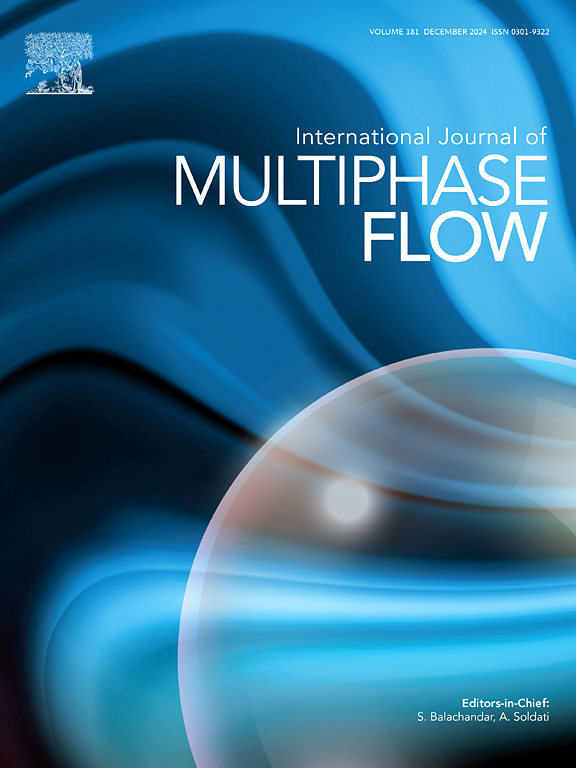芯片上实验室微腔填充机制的实验与数值研究
IF 3.6
2区 工程技术
Q1 MECHANICS
International Journal of Multiphase Flow
Pub Date : 2025-03-11
DOI:10.1016/j.ijmultiphaseflow.2025.105208
引用次数: 0
摘要
微腔的高效无空填充对于芯片实验室的应用具有重要意义。然而,由于以表面张力为主的局部流动效应,预测微腔在不同情况下是否会被填充仍然是困难的。在这项工作中,提出了对微腔填充过程的近距离研究,利用实验见解和3D数值模拟来阐明填充过程的机制。在考虑不同流体、毛细数和空腔深度的情况下,对微腔阵列上流体界面的运动进行了光学研究,揭示了不同填充状态的状态图。此外,考虑钉钉等小尺度效应,分析了孔洞上瞬态界面的演化过程。除了对图像序列进行视觉分析外,还利用自动评估工作流导出了动态接触角和界面级数的定量数据。在实验的基础上,采用三维流体体积模拟进一步研究了界面形状。结果表明,在大多数情况下,模拟不仅可以预测填充状态,还可以预测界面的瞬态运动和形状。与这项工作相关的数据和代码可在Bosch Research GitHub (Bosch, 2024)和TUdatalib数据存储库(Nagel等人,2024)上公开获取。本文章由计算机程序翻译,如有差异,请以英文原文为准。

Experimental and numerical study of microcavity filling regimes for Lab-on-a-Chip applications
The efficient and voidless filling of microcavities is of great importance for Lab-on-a-Chip applications. However, predicting whether microcavities will be filled or not under different circumstances is still difficult due to the local flow effects dominated by surface tension. In this work, a close-up study of the microcavity filling process is presented, shedding light on the mechanisms of the filling process using experimental insights accompanied by 3D numerical simulations. The movement of a fluid interface over a microcavity array is investigated optically under consideration of different fluids, capillary numbers, and cavity depths, revealing a regime map of different filling states. Moreover, the transient interface progression over the cavities is analyzed with attention to small-scale effects such as pinning. Besides the visual analysis of the image series, quantitative data of the dynamic contact angle and the interface progression is derived using an automated evaluation workflow. In addition to the experiments, 3D Volume-of-Fluid simulations are employed to further investigate the interface shape. It is shown that the simulations can not only predict the filling states in most cases, but also the transient movement and shape of the interface. The data and code associated with this work are publicly available at Bosch Research GitHub (Bosch, 2024) and at the TUdatalib data repository (Nagel et al., 2024).
求助全文
通过发布文献求助,成功后即可免费获取论文全文。
去求助
来源期刊
CiteScore
7.30
自引率
10.50%
发文量
244
审稿时长
4 months
期刊介绍:
The International Journal of Multiphase Flow publishes analytical, numerical and experimental articles of lasting interest. The scope of the journal includes all aspects of mass, momentum and energy exchange phenomena among different phases such as occur in disperse flows, gas–liquid and liquid–liquid flows, flows in porous media, boiling, granular flows and others.
The journal publishes full papers, brief communications and conference announcements.

 求助内容:
求助内容: 应助结果提醒方式:
应助结果提醒方式:


